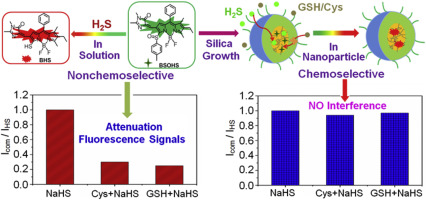Biomaterials ( IF 14.0 ) Pub Date : 2018-01-04 , DOI: 10.1016/j.biomaterials.2018.01.009 Feiyi Wang , Ge Xu , Xianfeng Gu , Zhijun Wang , Zhiqiang Wang , Ben Shi , Cuifen Lu , Xueqing Gong , Chunchang Zhao

|
Hydrogen sulfide (H2S) is an appealing signaling molecule that plays fundamental roles in health and disease. However, H2S-mediated selective chemical transformations for the construction of imaging probes are limited, retarding the interrogation of H2S-related biological processes. Here, we present an alternative approach for engineering a new generation of efficient probes with a nonchemoselective moiety as a building block. To demonstrate our design concept, we developed a sulfoxide-functionalized BODIPY that exhibited a substantial redshift in its absorption and emission spectra upon reduction with H2S. However, such a probe also showed reactivity toward various competing biothiols under aqueous buffers conditions. To achieve high chemoselectivity, we used core-shell silica nanoparticles as an encapsulation matrix to confine the designed molecule probe within their interiors. The inherent molecular-size sieving character of the porous silica shell was capable of impeding competing biothiols from accessing the molecule probe within the core while allowing the specific reaction with the small target H2S. Thus, this strategy avoided disturbance from coexisting biothiols and achieved highly chemoselective detection in ratiometric and near-infrared (NIR) turn-on fluorescence modes. In light of these promising features, together with fast responsiveness and favorable cellular uptake, such a silica nanocomposite was successfully used to detect the endogenous production of H2S in estrogen-induced cardiomyocytes and living mouse model. To our knowledge, the approach reported here is the first to exploit the usefulness of common thiol-sensitive moieties for building chemoselective probes.
中文翻译:

使用核-壳二氧化硅纳米粒子内部的荧光探针实现体内和体外H 2 S的高化学选择性检测
硫化氢(H 2 S)是一种有吸引力的信号分子,在健康和疾病中起着基本作用。然而,H 2 S介导的用于构建成像探针的选择性化学转化受到限制,从而阻碍了对H 2 S相关生物过程的研究。在这里,我们提出了一种以非化学选择性部分为构建基来设计新一代高效探针的替代方法。为了证明我们的设计理念,我们开发了一种亚砜官能化的BODIPY,当被H 2还原时,其吸收和发射光谱呈现出明显的红移。然而,这种探针在水性缓冲液条件下也显示出对各种竞争生物硫醇的反应性。为了实现高化学选择性,我们使用核-壳二氧化硅纳米粒子作为封装基质,将设计的分子探针限制在其内部。多孔硅壳的固有分子筛筛分特性能够阻止竞争的生物硫醇进入核内的分子探针,同时允许与小靶标H 2的特异性反应S.因此,该策略避免了共存生物硫醇的干扰,并在比例和近红外(NIR)开启荧光模式下实现了高度化学选择性的检测。鉴于这些有希望的特征,以及快速的响应性和良好的细胞摄取,这种二氧化硅纳米复合材料已成功用于检测雌激素诱导的心肌细胞和活体小鼠模型中H 2 S的内源性产生。据我们所知,这里报道的方法是第一个利用常见的硫醇敏感性基团构建化学选择性探针的有用性的方法。



























 京公网安备 11010802027423号
京公网安备 11010802027423号